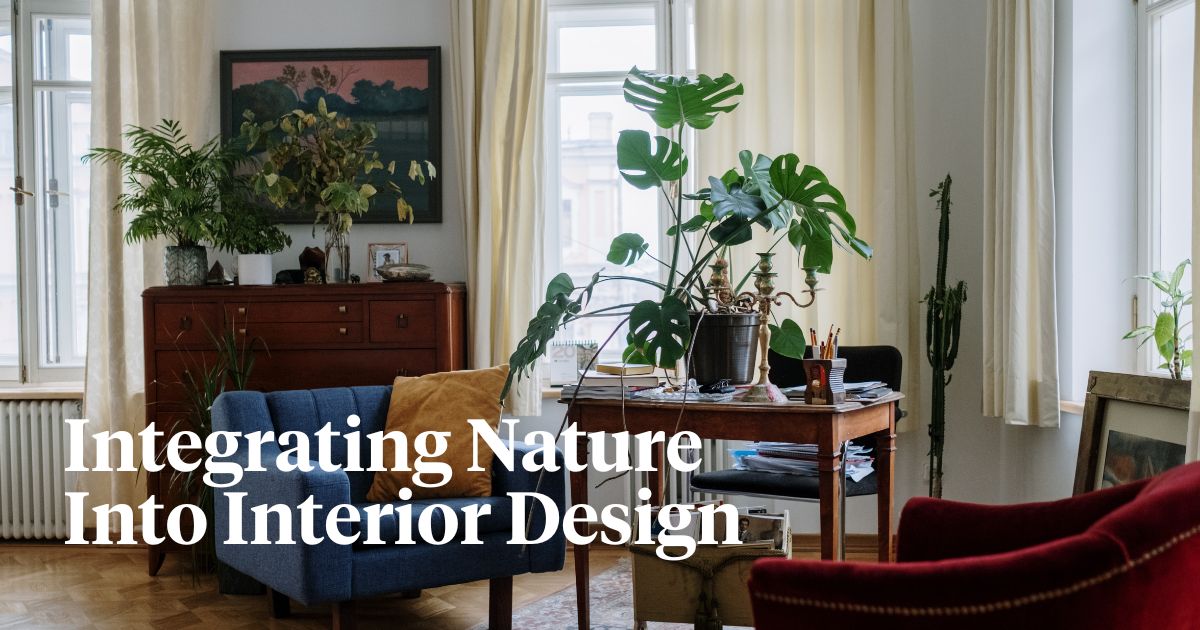Integrating nature into design creates a harmonious and sustainable living environment. Incorporating elements of nature into design has become increasingly popular in recent years.
This approach not only enhances the aesthetic appeal of a space but also creates a sense of tranquility and connection with the natural world. By using materials such as wood, stone, and natural fibers, designers can bring a sense of warmth and authenticity to their creations.
Additionally, incorporating natural light and vegetation into the design can improve the overall well-being and productivity of the occupants. Whether it is through biophilic architecture, sustainable landscaping, or the use of organic shapes and patterns, integrating nature into design is a powerful way to create spaces that are both visually stunning and environmentally conscious.
Benefits Of Integrating Nature Into Design
Integrating nature into design offers numerous benefits, including improved well-being, increased productivity, and enhanced aesthetic appeal. By incorporating natural elements such as plants, natural light, and organic materials, spaces become more harmonious and conducive to a healthier and more enjoyable experience.
Benefits of Integrating Nature into Design
Integrating nature into design has numerous benefits for individuals' overall well-being. Studies have shown that being exposed to natural elements, such as plants and greenery, has a positive impact on well-being by improving overall mood and reducing stress and anxiety levels. Nature-inspired design elements in the form of colors, patterns, and textures can create a soothing and calming environment, helping individuals to feel more relaxed and at ease. This, in turn, enhances overall well-being and promotes a sense of tranquility and happiness.
Moreover, integrating nature into design has been found to improve productivity. Research has shown that being in a natural environment or incorporating natural design elements can enhance focus, concentration, and creativity. Exposure to nature or nature-inspired design has been linked to improved cognitive performance and problem-solving abilities. By incorporating natural elements into the design, individuals can experience a heightened sense of energy and vitality, leading to increased productivity in various settings, such as workplaces and educational institutions.
Additionally, integrating nature into design plays a significant role in reducing stress and anxiety. The presence of natural elements can help create a sense of calm and tranquility, providing individuals with a respite from the demands and pressures of daily life. Natural settings or nature-inspired design elements have been shown to lower heart rate, blood pressure, and cortisol levels, all of which are indicators of a reduced stress response. By incorporating nature into design, individuals can create spaces that promote relaxation, allowing them to unwind and de-stress. This, in turn, contributes to improved mental well-being and a greater sense of overall happiness.
Strategies For Integrating Nature Into Design
Integrating nature into design can greatly enhance the aesthetic appeal and functionality of any space. Biophilic design, which focuses on incorporating natural elements, is an effective strategy for achieving this. Two popular approaches include living walls and vertical gardens. These vertical plant installations not only add a touch of greenery but also improve air quality and reduce noise levels. Another important aspect to consider is natural lighting. Maximizing the use of daylight not only saves energy but also creates a healthier and more pleasant environment. Incorporating large windows, skylights, and light wells can greatly increase the natural light in a space, creating a connection between outdoor and indoor spaces. By incorporating these strategies, designers can create spaces that not only look beautiful but also promote well-being and a closer connection to nature.
Case Studies Of Successful Integration
Nature-inspired designs can significantly enhance the appeal and functionality of various spaces. Let's explore some successful integration of nature in different types of spaces:
Residential Spaces
In residential areas, incorporating natural elements creates a soothing and harmonious atmosphere. Homes can be designed with large windows, allowing natural light to flood in and offering beautiful views of the surrounding greenery. Adding indoor plants, vertical gardens, or rooftop gardens can create a sense of serenity and improve air quality, promoting a healthier living environment.
Commercial Spaces
Nature-integrated designs in commercial spaces can have numerous benefits. Offices with biophilic features, such as green walls and natural materials, can improve employee productivity and well-being. Retail stores can utilize natural elements like wood textures, natural lighting, and indoor greenery to create a calming and inviting ambiance for customers, boosting sales.
Public Spaces
In public spaces, integrating nature can enhance the overall experience and attract visitors. Parks and recreational areas with abundant green spaces, water features, and walking trails create opportunities for relaxation and physical activities. Urban plazas can be transformed with strategic landscaping, street trees, and seating areas, providing an inviting oasis amidst the hustle and bustle of the city.

Credit: marveldesigns.com
Challenges And Considerations
Incorporating nature into design can bring numerous benefits to a space, but there are several challenges and considerations that need to be addressed. Maintenance and upkeep is one of the key factors to keep in mind. While adding natural elements such as plants, trees, or water features can enhance the aesthetics, they also require regular care and attention. Without proper maintenance, these elements can quickly become overgrown or lackluster, diminishing the overall appeal. Another consideration is space limitations. Integrating nature into design must take into account the available space and ensure that it does not overcrowd or compromise the functionality of the area. Lastly, budget constraints can play a significant role in the design process. Nature-based design elements often require additional expenses for installation, ongoing maintenance, and replacement. Balancing the desired design aesthetic with the available budget is crucial to the success of the project.

Credit: thursd.com
Frequently Asked Questions Of Integrating Nature Into Design,
How Can Nature Be Integrated Into Design?
Nature can be integrated into design by using natural materials, incorporating natural elements like plants and water features, and implementing biophilic design principles that enhance the connection between humans and nature. This integration creates a more harmonious and sustainable environment.
What Are The Benefits Of Integrating Nature Into Design?
Integrating nature into design has numerous benefits. It improves air quality, reduces stress levels, boosts productivity and creativity, enhances overall well-being, and promotes sustainability. By having nature-inspired spaces, individuals are more likely to feel calm, inspired, and connected to the environment around them.
How Does Biophilic Design Affect Human Health?
Biophilic design has a positive impact on human health. It reduces stress, lowers blood pressure and heart rate, improves cognitive function, promotes healing, and enhances overall well-being. Being in spaces that replicate nature's patterns, colors, and textures can improve mood and create a sense of peace and tranquility.
Conclusion
Designing with nature in mind not only enhances aesthetic appeal but also promotes sustainability. By incorporating natural elements into our designs, we create spaces that are harmonious with the environment, promoting well-being and reducing our ecological footprint. From biophilic architecture to sustainable landscaping, there are countless ways to integrate nature into design.
So, whether you are an architect, interior designer, or homeowner, embracing nature will enrich your spaces and contribute to a greener future. Let's create beautiful designs that coexist with nature for a brighter and more sustainable tomorrow.

 inews69
inews69
